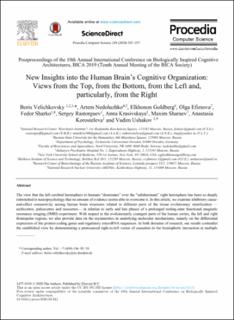| dc.contributor.author | Velichkovsky, Boris | |
| dc.contributor.author | Nedoluzhko, Artem | |
| dc.contributor.author | Goldberg, Elkhonon | |
| dc.contributor.author | Efimova, Olga | |
| dc.contributor.author | Sharko, Fedor S. | |
| dc.contributor.author | Rastorguev, Sergey M | |
| dc.contributor.author | Krasivskaya, Anna | |
| dc.contributor.author | Sharaev, Maxim | |
| dc.contributor.author | Korosteleva, Anastasia | |
| dc.contributor.author | Ushakov, Vadim | |
| dc.date.accessioned | 2020-07-20T07:17:10Z | |
| dc.date.available | 2020-07-20T07:17:10Z | |
| dc.date.created | 2020-04-18T21:36:50Z | |
| dc.date.issued | 2020 | |
| dc.identifier.citation | Velichkovsky, B., Nedoluzhko, A., Goldberg, E., Efimova, O., Sharko, F. S., Rastorguev, S. M., Krasivskaya, A., Sharaev, M., Korosteleva, A. & Ushakov, V. (2020). New insights into the human brain’s cognitive organization: Views from the top, from the bottom, from the left and, particularly, from the right. Procedia Computer Science, 169, 547-557. doi: | en_US |
| dc.identifier.issn | 1877-0509 | |
| dc.identifier.uri | https://hdl.handle.net/11250/2669683 | |
| dc.description.abstract | The view that the left cerebral hemisphere in humans “dominates” over the “subdominant” right hemisphere has been so deeply entrenched in neuropsychology that no amount of evidence seems able to overcome it. In this article, we examine inhibitory cause-and-effect connectivity among human brain structures related to different parts of the triune evolutionary stratification —archicortex, paleocortex and neocortex— in relation to early and late phases of a prolonged resting-state functional magnetic resonance imaging (fMRI) experiment. With respect to the evolutionarily youngest parts of the human cortex, the left and right frontopolar regions, we also provide data on the asymmetries in underlying molecular mechanisms, namely on the differential expression of the protein-coding genes and regulatory microRNA sequences. In both domains of research, our results contradict the established view by demonstrating a pronounced right-to-left vector of causation in the hemispheric interaction at multiple levels of brain organization. There may be several not mutually exclusive explanations for the evolutionary significance of this pattern of lateralization. One of the explanations emphasizes the computational advantage of separating the neural substrates for processing novel information ("exploration") mediated predominantly by the right hemisphere, and processing with reliance on established cognitive routines and representations ("exploitation") mediated predominantly by the left hemisphere. | |
| dc.language.iso | eng | en_US |
| dc.publisher | Elsevier | en_US |
| dc.rights | Attribution-NonCommercial-NoDerivatives 4.0 Internasjonal | * |
| dc.rights.uri | http://creativecommons.org/licenses/by-nc-nd/4.0/deed.no | * |
| dc.title | New insights into the human brain’s cognitive organization : Views from the top, from the bottom, from the left and, particularly, from the right | en_US |
| dc.type | Peer reviewed | en_US |
| dc.type | Journal article | en_US |
| dc.description.version | publishedVersion | en_US |
| dc.rights.holder | © 2020 The Author(s) | en_US |
| dc.subject.nsi | VDP::Medisinske Fag: 700::Klinisk medisinske fag: 750::Nevrologi: 752 | en_US |
| dc.subject.nsi | VDP::Samfunnsvitenskap: 200::Psykologi: 260::Kognitiv psykologi: 267 | en_US |
| dc.source.pagenumber | 547-557 | en_US |
| dc.source.volume | 169 | en_US |
| dc.source.journal | Procedia Computer Science | en_US |
| dc.identifier.doi | 10.1016/j.procs.2020.02.211 | |
| dc.identifier.cristin | 1806974 | |
| dc.relation.project | Russian Science Foundation: 17-78-30029. | en_US |
| dc.relation.project | Russian Foundation of Basic Research: 18-29-23020 | en_US |
| dc.relation.project | Russian Foundation of Basic Research: 18-00-00569 | en_US |

